
clés. Les piles ou le conducteur peut
surchauffer et causer des blessures.
Respectez la polarité adéquate entre la
pile et le chargeur.
• Les bloc-piles rechargeables à l’hydrure
métallique de nickel: Jetez ces blocs-piles
de manière écologique et sécuritaire. Ne
les incinérez pas et ne les percez pas.
Tel que les autres piles de ce type, elles
pourraient dégager une matière toxique
qui peut causer des blessures corporelles
si elles sont brûlées ou percées.
The RBRC® seal
The RBRC® seal on the nickel-metal
hydride battery indicates that VTech
Communications, Inc. is voluntarily
participating in an industry program to
collect and recycle these batteries at the
end of their useful lives, when taken out of
service within the United States and Canada.
The RBRC® program provides a convenient
alternative to placing used nickel-metal
hydride batteries into the trash or municipal
waste, which may be illegal in your area.
VTech’s participation in RBRC® makes it easy
for you to drop off the spent battery at local
retailers participating in the RBRC® program
or at authorized
VTech product service centers. Please call
1 (800) 8 BATTERY®
for information on Ni-
MH battery recycling and disposal bans/
restrictions in your area.
VTech’s involvement in this program is
part of its commitment to protecting
our environment and conserving natural
resources.
RBRC® and 1 (800) 8 BATTERY® are
registered trademarks of Call2recycle, Inc.
FCC, ACTA and IC regulations
FCC Part 15
This equipment has been tested and found
to comply with the requirements for a Class
B digital device under Part 15 of the Federal
Communications Commission (FCC) rules.
These requirements are intended to provide
reasonable protection against harmful
interference in a residential installation.
This equipment generates, uses and can
radiate radio frequency energy and, if not
installed and used in accordance with the
instructions, may cause harmful interference
to radio communications. However, there
is no guarantee that interference will not
occur in a particular installation. If this
equipment does cause harmful interference
to radio or television reception, which can
be determined by turning the equipment
off and on, the user is encouraged to try to
correct
the interference by one or more of the
following measures:
• Reorient or relocate the receiving
antenna.
• Increase the separation between the
equipment and receiver.
• Connect the equipment into an outlet on
a circuit different from that to which the
receiver is connected.
• Consult the dealer or an experienced
radio/TV technician for help.
Changes or modifications to this equipment
not expressly approved by the party
responsible for compliance could void the
user’s authority to operate the equipment.
This device complies with Part 15 of the FCC
rules. Operation is subject to the following
two conditions:
(1) this device may not cause harmful
interference, and
(2) this device must accept any interference
received, including interference that may
cause undesired
operation. Privacy of communications may
not be ensured when using this telephone.
To ensure safety of users, the FCC/ISEDC
has established criteria for the amount of









































